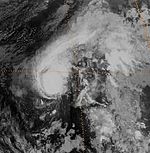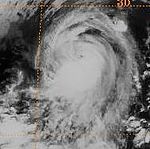1982 Pacific typhoon season
| 1982 Pacific typhoon season |

Season summary map
|
| Seasonal boundaries |
| First system formed |
March 16, 1982 |
| Last system dissipated |
December 12, 1982 |
| Strongest storm |
|
| Name |
Mac |
| • Maximum winds |
220 km/h (140 mph)
(10-minute sustained) |
| • Lowest pressure |
895 hPa (mbar) |
| Seasonal statistics |
| Total depressions |
29 |
| Total storms |
25 |
| Typhoons |
19 |
| Super typhoons |
2 |
| Total fatalities |
523-597 |
| Total damage |
> $2.41 billion (1982 USD) |
| Related articles |
|
|
Pacific typhoon seasons
1980, 1981, 1982 1983, 1984
|
| Severe tropical storm (JMA) |
| Tropical storm (SSHWS) |
|
|
| Duration |
March 16 – March 24 |
| Peak intensity |
95 km/h (60 mph) (10-min) 990 hPa (mbar) |
| Typhoon (JMA) |
| Category 3 typhoon (SSHWS) |
|
|
| Duration |
March 19 – April 1 |
| Peak intensity |
185 km/h (115 mph) (10-min) 935 hPa (mbar) |
| Typhoon (JMA) |
| Category 1 typhoon (SSHWS) |
|
|
| Duration |
March 29 – April 5 |
| Peak intensity |
140 km/h (85 mph) (10-min) 965 hPa (mbar) |
| Typhoon (JMA) |
| Category 3 typhoon (SSHWS) |
|
|
| Duration |
May 17 – May 24 |
| Peak intensity |
165 km/h (105 mph) (10-min) 945 hPa (mbar) |
| Typhoon (JMA) |
| Category 1 typhoon (SSHWS) |
|
|
| Duration |
June 21 – June 27 |
| Peak intensity |
130 km/h (80 mph) (10-min) 975 hPa (mbar) |
| Tropical storm (JMA) |
| Tropical storm (SSHWS) |
|
|
| Duration |
June 28 – July 3 |
| Peak intensity |
85 km/h (50 mph) (10-min) 985 hPa (mbar) |
| Tropical storm (JMA) |
| Tropical storm (SSHWS) |
|
|
| Duration |
June 29 – July 1 |
| Peak intensity |
85 km/h (50 mph) (10-min) 992 hPa (mbar) |
| Severe tropical storm (JMA) |
| Tropical storm (SSHWS) |
|
|
| Duration |
July 12 – July 17 |
| Peak intensity |
95 km/h (60 mph) (10-min) 985 hPa (mbar) |
| Tropical depression (JMA) |
|
|
| Duration |
July 16 – July 19 |
| Peak intensity |
<55 km/h (35 mph) (10-min) 1006 hPa (mbar) |
The 1982 Pacific typhoon season had no official bounds; it ran year-round in 1982. On average, most tropical cyclones tend to form in the northwestern Pacific Ocean between May and November. These dates conventionally delimit the period of each year when most tropical cyclones form in the northwestern Pacific Ocean. The scope of this article is limited to the Pacific Ocean, north of the equator and west of the International Date Line. Storms that form east of the date line and north of the equator are called hurricanes.
Tropical Storms that formed in the entire west Pacific basin were assigned a name by the Joint Typhoon Warning Center. Tropical depressions that enter or form in the Philippine area of responsibility are assigned a name by the Philippine Atmospheric, Geophysical and Astronomical Services Administration or PAGASA. This can often result in the same storm having two names.
During this season, the first tropical cyclone formed on March 16, and the last one dissipated on December 12. A total of 29 tropical depressions formed this year in the Western Pacific, of which 25 became tropical storms. 19 storms reached typhoon intensity, of which 2 reached super typhoon strength. Two-thirds of the tropical cyclones formed between July and October. Typhoon Pamela was the longest-lived tropical cyclone of the season. Sixteen of the cyclones struck land during their life cycles, with eight moving through the Philippines. Tropical cyclones accounted for 35 percent of the 1982 rainfall across Hong Kong, their fifth wettest tropical cyclone contribution on record at the time. Nearly half of the deaths during the season were the result of Typhoon Nancy moving through the Philippines and Vietnam in October.
A total of 28 tropical depressions formed this year in the Western Pacific, of which 26 became tropical storms. 19 storms reached typhoon intensity, of which 2 reached super typhoon strength. Three tropical cyclones formed in March (most active since 1967,) one in May, three in June, four in July, five in August, six in September, four in October, one in November, and one in December. Typhoon Pamela (Aning) was the longest-lived tropical cyclone of the season. Sixteen tropical cyclones made landfall, with eight moving through the Philippines, four striking China, three impacting Vietnam, and three crossing Japan. Tropical cyclones accounted for 35 percent of the 1982 rainfall across Hong Kong, their fifth wettest tropical cyclone contribution on record at the time.
...
Wikipedia


















